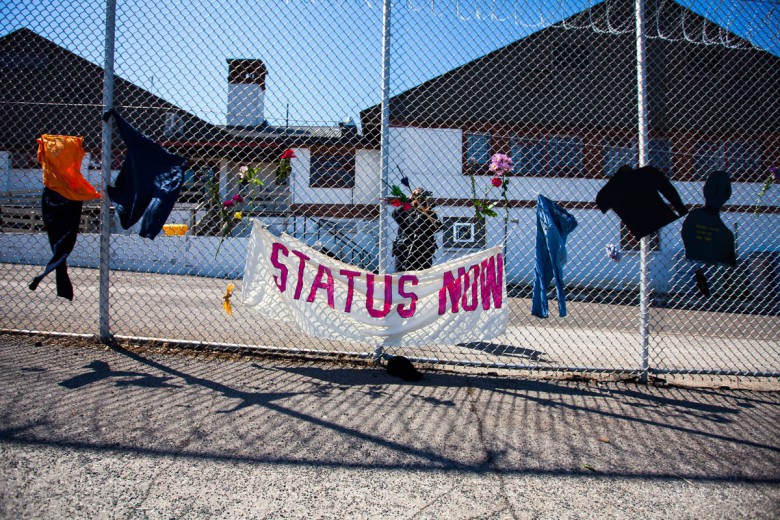
Being an activist has a way of teaching you how to lose gracefully. Or, at least, how to lose. In my activist career I’ve worked in many different campaigns on a diverse array of issues, but virtually every single campaign I’ve been involved in has been a losing battle, with the particular problems we were fighting against becoming measurably worse despite our efforts. There has been one exception: the movement to build local, ecologically sound food systems.
When it comes to food activism, we seem to have reached a tipping point. The “100-mile diet” is now a household phrase. The idea of supporting local family farmers has wide appeal and support even in relatively mainstream demographics. Food and farm groups I’ve worked with have seen an upsurge of support and number of allies, and concrete indicators like the number of new, locally oriented farms are very promising.
Of course, the different issues I’ve worked on aren’t really disparate. They have shared causes, and often have shared solutions. So why is this particular movement now seeing considerable success? And what lessons of this success can be applied to other struggles?
First, the bad news
The trajectory of agriculture has, from the beginning, mirrored the trajectory of industrial civilization more broadly. The food and farm problems that affect farmers and eaters alike stem from the same basic trends and imperatives – the key trend being the increasing centralization of power, as coercive, hierarchical relations have replaced voluntary, egalitarian ones. There’s no unfathomable or mystical reason for this. Powerful but ruthless people want to become more powerful, to centralize and increase their ability to control, and along the way they’ve developed increasingly complex tools, technologies and institutions to further this aim: capitalism, the modern state, industrialization, and agricultural methods like annual monocultures. The more power gets concentrated in fewer hands, the more the powerful are able to impose their exploitative systems on others.
Industrial civilization is based on taking more than it gives back, and this is particularly true for industrial agriculture. The food in the grocery store may be cheap in financial terms, but causes ecological havoc and requires 10 times as much fossil fuel energy as we actually get from eating it. Intensive irrigation has led to the serious depletion of freshwater supplies around the world. In grain-growing regions of China, water tables are dropping by up to 20 feet per year. In rural India, deep industrial wells are causing traditional hand-dug wells to run dry – up to 95 per cent of the wells in some areas. Soil, too, has suffered degradation worldwide, with about one per cent of the planet’s topsoil being lost each year. Over the last 50 years, according to the Millennium Ecosystem Assessment, 40 per cent of all agricultural land has become degraded, and 30 per cent of the Earth’s entire land surface is at risk of degradation. And of course, labour-intensive crops including most fruits and vegetables typically rely on poorly paid and poorly treated agricultural labourers, often imported from poorer nations and regions. With all of these serious long-term problems, the only reason the entire system still grinds on is because the crises are masked by a very temporary supply of cheap fossil fuels.
So “cheap” food in the global north has an enormous externalized cost, which is paid by those living in the global south, by the planet itself, and ultimately by future generations, who will live in a world of depleted soils and scarce water supplies, a world without cheap fossil fuels but still wracked by global warming.
In a finite world, a system that depends on exponential growth will eventually overshoot its resource base and trigger its own collapse. That basic law of nature seems destined to again prove itself within our lifetimes.
Because of the growing awareness of peak oil in particular, more and more people are starting to realize that industrial humans are not exempt from the laws of nature, that we may soon have to depend on local networks and resources for our survival. This, certainly, is one of the more pragmatic reasons for building local food systems. The depletion of fossil fuels means that industrially produced food will continue to become more and more expensive, which will give a boost to local food movements. But building a sustainable local food system takes considerable lead time, and one of the goals of grassroots food movements is to try to ensure that food is being grown and equitably distributed as the industrial system approaches the point at which it can externalize consequences no longer.
Harvesting solutions
If agriculture is a microcosm of society, then solutions to the food crisis may ultimately be transferable to other, larger problems we face. Where I live, near Kingston, Ontario, many different promising projects are currently underway. The National Farmers Union (Local 316), for instance, has spearheaded projects like Food Down the Road, a broadly based initiative with backing from farmers, eaters, public health workers, academics and a plethora of other allies. Here and elsewhere, Community-Supported Agriculture (CSA) ventures have seen dramatic growth in recent years, both in terms of the number and size of farms. Community gardens and urban agriculture projects, which once struggled for land and recognition, have begun to enjoy growing popular and municipal support. Together, projects like these, springing up all over North America and around the world, form the embryo of a new approach to growing and distributing food. Particularly exciting, though, is the possibility that characteristics of this approach can be applied to other social and environmental struggles.
One characteristic that many local food projects share is an ability to simultaneously draw on and develop community. A number of different surveys have shown that the primary reason people buy local food is not for environmental reasons or even for health reasons. Instead, the most important reason seems to be that buying local food supports family farmers and the local economy – it directly helps their neighbours and their community. Another key reason identified is that people believe (for good reason) that local food is fresher and of better quality. For most people, the desire to support family farmers and local food doesn’t seem to stem from an anti-capitalist or anti-corporate perspective, but from an almost mythic emotional attachment to the idea of the family farm.
At the same time, these projects help to build new community links and personal relationships. Food acts as an entry point for community-strengthening efforts. It can be difficult to find such a convenient entry point for many other struggles. Grassroots food movements have the potential to cross barriers of race, class and gender and build new relationships of interdependence by bringing people together in many overlapping ways: socially (potlucks and other gatherings), economically (farmers’ markets, CSAs, food co-operatives) and physically (people working together to grow, distribute or prepare food). These different activities often have an explicit component of mutual education, in which different parties try to learn from and about each other. (Many of these same activities also help grassroots food movements recruit and retain participants more effectively than other movements with which I’ve worked.) Also key is that, in many of these examples, people with disparate experiences are working together as allies toward a common goal, rather than members of a homogeneous (and usually privileged) group trying to be charitable towards another. Opportunities to emulate these successes are harder to find in some struggles than others, but are invaluable whenever they can be created.
Another characteristic of many successful food projects is a focus on immediate tangible rewards for participants. For global problems like climate change, individual acts, even dramatic ones, can have no perceptible impact on the problem. But when it comes to food politics, even individual acts like going down to a farmers’ market or buying and preparing delicious food offer direct rewards for involvement. Larger-scale efforts like CSAs or community gardens offer even greater benefits – benefits that are both tangible and shared with others. Many movements in the global north that deal with environmental and social justice problems have relied either on trying to guilt privileged people into changing their actions, or to make them feel good about doing the right thing without in any way changing the social, economic and political institutions that maintain the balance of power. But the benefits of local food go far beyond individual feelings of guilt or moral virtue. Entire communities, not just particular individuals, can benefit from building a healthy and sustainable local food system. The broad social collaboration needed to develop and maintain such a system offers an opportunity to move beyond charity-based models of social justice and break through barriers of class, age, ethnicity and so on.
Short-term gain, long-term gain
A healthy local food system offers both immediate and long-term benefits to the participants. This contrasts sharply with many environmental “solutions” that ask people to make short-term sacrifices in exchange for long-term gain. It also contrasts with the status quo, which insists on the pursuit of immediate ostensible benefits (usually involving some combination of increased material wealth, comfort and convenience) at horrendous long-term expense. To some extent we can try to adjust our strategy in other struggles to offer more immediate benefits, but sometimes we can’t or shouldn’t. Many injustices are so deeply entrenched that only breaking down monolithic systems of power and inhibiting the ability of the powerful to externalize the consequences of their actions will allow them to be resolved. Nevertheless, it’s worth recognizing the power and appeal of activities that align the short- and long-term interests of participants so that doing the right thing makes sense both immediately and in the long run. Recognizing and building campaigns around such actions whenever possible can help us to involve more people and gain momentum.
Another characteristic of many local food initiatives is the very low barriers to entry for new participants. To buy or eat local food, you don’t need to have any special skills or equipment; you don’t need to know a lot about history or agriculture; you don’t even have to have that much money. Sure, it would be difficult to eat 100 per cent local food, but one of the reasons that these movements are succeeding is you don’t have to do that to make a difference or to experience the benefits. In most areas, only a tiny percentage of food is sourced locally. If a city were sourcing two per cent of its food locally, an increase to four per cent would mean a negligible difference in terms of cost or convenience. But such a change would make a huge difference for local agriculture, because it would double the number of farmers who could be supported.
Local food activism has other reasons for its broad appeal as well. Food is universal common ground: everyone eats. Everyone knows that good food is important. And importantly (and unlike many other struggles), involvement in local food projects is pretty non-threatening – it’s relatively low-risk, because for most people it doesn’t involve confrontations with power. Of course, confrontations with power do happen all the time: farmers threatened with foreclosure by the bank, community gardeners fighting to prevent their garden plots from being bulldozed and developed, farmers like raw-milk dairy farmer Michael Schmidt who struggle for food autonomy. But people don’t have to start there. And when those confrontations do happen, it’s usually not perceived as a group of out-of-touch radicals trying to create some pie-in-the-sky utopia. It’s about protecting the rights of farmers: hard-working people with a traditional and respected social role.
A shift toward locally produced, sustainably grown food has a plurality of benefits. Widely implemented, this shift can reduce or eliminate many of the problems discussed above by building real community and distributing power, fostering autonomy and solidarity, preserving soil and biodiversity, strengthening local economies and reducing hunger.
Of course, local food is not a cure-all. Those in power – whether we are talking about agrochemical corporations or those who hold power over broader society – got there specifically by destroying local food systems and other small-scale egalitarian communities and substituting coercive hierarchical relations from which they could extract profit. North American settlers, for instance, wiped out the vast herds of bison in large part to starve out indigenous nations resisting their invasion. Local food is still relatively marginal, but the more successful we are, the greater a threat we pose to those in power and to their ability to make a profit. Historians of the Black Panther Party write that it wasn’t black people with guns that the government was most afraid of, but their community organizing against oppression, especially through various community food programs. Writes historian Curtis J. Austin: “To achieve its goal, government agencies had not only to destroy Panther facilities and supplies, but to arrest, beat, imprison, and sometimes kill those responsible for making the Free Breakfast for Children Program work.” We shouldn’t delude ourselves – just knowing how to build and run a healthy food system isn’t enough. We also need to know how to defend it.
And there are still many challenges facing local ecological food initiatives. The decades-long obliteration of rural communities in general and farms in particular means that there simply aren’t enough skilled farmers to grow even a fraction of the food we need. This is actually a very tractable problem. Undertakings like the National Farmers Union’s New Farm Project aim to “build farm community and build farm capacity” by training new farmers, sharing skills and techniques, and chipping away at barriers to those who would like to grow their own food. Such efforts are rapidly growing and proliferating, and embody considerable potential.
Two allied threads
We have many reasons to be optimistic about the popularity and growth of local, ecologically grown food and its potential to both spark and fuel broader movements for ecological sanity and healthy communities built on mutual aid. The benefits are tremendous, and the work already underway is something to be celebrated. Nonetheless, many of the essential problems facing the planet – climate change, soil loss, water drawdown – affect agriculture directly, and unless they are stopped, they will make any future shift to a lower-energy way of life increasingly difficult.
Building just, ecologically sound food systems is very important and necessary work – necessary, but not sufficient. Our sustainable gardens cannot feed us if their soil is destroyed or sealed under pavement, or if a runaway greenhouse effect bakes our crops in the field. Every day that industrial civilization grinds on is a day that the Earth’s carrying capacity is drastically reduced. Alarmingly, soil scientist Peter Salonius estimates that once petroleum has been exhausted, the soils of the Earth will be so degraded that the planet will only be able to support between 100 million and 300 million people. If we don’t stop this destruction, our carefully tended groves and garden plots will be nothing more than after-dinner snacks for an insatiable civilization.
Ultimately, the fight to preserve a livable planet bolsters the success of all our struggles for justice and freedom. What we need are two allied threads, each making the most of its unique strengths. One thread is a popular movement toward local, sustainable and equitable food systems. The other is a more confrontational movement of serious resistance at every level to the ongoing devastation of the planet. The building of alternatives that can sustain future generations once the current model collapses is necessary, but ultimately the success of those alternatives depends upon our effective resistance to industrial civilization now.
If we can mount that resistance while building up local food security, I genuinely believe that we will win.





_780_520_90_s_c1.jpg)
